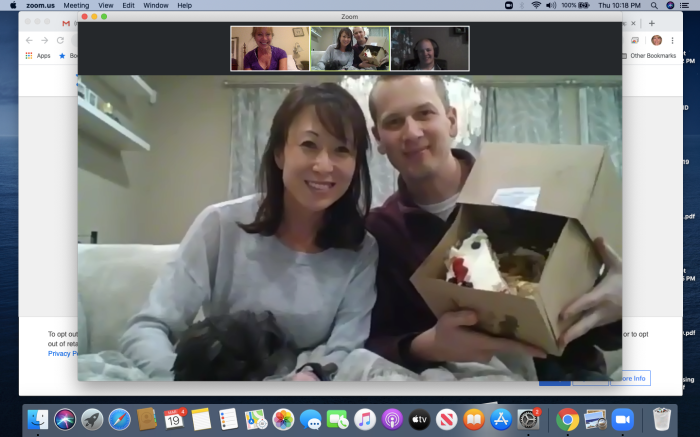Context: Coronavirus
Unless your from another planet or just returned from a long solitary meditation retreat (like actor, Jared Leto), you have likely been asked to take several precautions in the face of this novel coronavirus (also referred to as Covid-19 and SARS-CoV-2) outbreak, which has been characterized as a pandemic by the World Health Organization as of March 11, 2020. The situation remains dire and Legislators around the world are asking us to each do our part in minimizing the spread of the virus. Visit the CDC’s website for the latest recommendations on ways to prevent the spread and measures to take if you think you’ve been exposed.
Ideas to stay safe, connected, and entertained
Since the grim news about the infection rate, mortality rate, and social and economic toll (e.g., Washington Post; Vox; CNN; fivethirtyeight; NPR) is being thoroughly covered by the media, I thought I would follow the lead of my mother-in-law and fellow blogger, Yvette Francino, in sharing ideas for safely socializing, up-skilling, volunteering, donating and staying healthy and entertained during the outbreak. Before you go through my list, I highly recommend that you look through her list of great ideas, which you can read on her blog (full disclaimer: I am featured on her blog because I celebrated my birthday virtually through the meeting app, Zoom):

Socialize
Virtual Meetings for 3+ people
- Zoom works on most devices (e.g., Mac, Windows, Linux) and offers a free basic plan. One thing to note is that if you sign up for the free tier, your meetings are limited to 40 minutes if there are 3+ participants meetings a with the max number of participants capped at 100. There are no time caps for 1:1 meetings. If you are a K-12 educator, Zoom is currently offering you access to their platform for free (see this Forbes article for details).
- Skype also works on most devices and offers a free plan. It’s unclear whether Skype allows multiple participants.
- Google Hangouts also works on most devices and is free, with a Google account. You can host up to 10 people under the free plan.
Stay Entertained
Gaming Platforms
- Steam is a popular game distributor that works on Windows, Mac, Linux, and mobile devices. They have some games that are available for free but most games are not free. Some of my favorites are the Jackbox Party series, which you can play with friends by hosting a game on one of the virtual meeting apps I listed above. Note that to play the Jackbox games virtually with your friends, they’ll need two devices: one for the meeting app to view the shared screen and another to play the games (they recommend a mobile device).
- Origin is another popular gaming platform that works on most devices and offers free games but most games are not free.
Not a gamer but enjoy watching others play games? Then there’s always Twitch. You can also watch and support artists and musicians on Twitch as well (e.g. musicians channel).
Virtual Concerts & Tours
- Several artists and musicians are streaming live performances (see this list curated by NPR)
- Browse or take a virtual tour of over 2500 museums and galleries around the world. CNN also shared several links to recorded concerts and virtual tours of museums around the world.
- You can also take a virtual tour of 5 National Parks thanks to Google.
- Catch a free, live show hosted by the Metropolitan Opera
- Watch cute animals through the live cam at the San Diego Zoo, Houston Zoo, Georgia Aquarium, Atlanta Zoo, Cincinnati Zoo, and Monterey Bay Aquarium.
- Browse the through a Free Music Archive.
Read
- You can access and download over 300,000 ebooks from the New York Public Library for free; 61,494 free ebooks from Gutenberg; and many more from sites like Open Library and Open Culture.
- Join a virtual book club like this one that’s organized by Walt Hickey, the author of the Numlock News series which I also highly recommend subscribing to.
or listen to a free audio book from LibriVox.
Stay Healthy
Exercise
- Practice yoga for free with great YouTube instructors like Sara Beth who has 10-60 minute videos on different types of practices with modifications to accommodate all skill levels and abilities. You can also pay for platforms like CorePower Yoga.
- Several studios are also streaming free fitness classes online, like LifeTime Fitness, YMCA360, Blink Fitness and Planet Fitness, or cardio dance classes like 305 Fitness.
Mental Health
- Breathe2Relax is a free stress management app for iOS and Android that was developed by the U.S. Department of Veterans Affairs for anyone coping with trauma and anxiety. The VA has also developed other free apps that you may enjoy as well, like the Mindfulness app.
- 7 Cups for iOS and Android is a free app that connects you to caring listeners for emotional support. They also provide online therapy for as little as $150 a month.
- Talkspace for iOS and Android is an app that connects you with licensed therapists. They have multiple pricing tiers that range from $260 a month to $396 a month. They also offer couples therapy. More information on pricing here.
- BetterHelp is an online text-based or chat-based counseling platform that connects you to therapists that specialize in individuals, couples, and adolescents. They charge between $40 to $70 per week.
- Gottman Apps for iOS and Android is a free app developed by clinical psychologists, John and Julie Schwartz Gottman, and designed for couples.
- Calm is a free mediation app for iOS and Android devices. Headspace for iOS and Android is a guided meditation app. It’s available by subscription only and costs $12.99 a month or you can pay $95.88 for the full year.
If you’re in serious crisis, you can always call the Suicide Prevention Lifeline, toll-free, at 1-800-273-8255.
Learn
- You can enjoy several free online courses that were developed by prestigious institutions like MIT, Harvard, and Berkeley through education platforms like edx and Coursera. Here’s a list of free culture courses from Harvard. There are also education platforms that are not free but offer nano degrees, like Udacity, or are fee-per-course and cover a range of topics such as Udemy, or are subscription based like Skillshare and Brilliant.
- There are tons of incredible Creators that you can watch and learn from on YouTube for free. Some of my favorite include Destin from Smarter Every Day, Grant Sanderson from 3Blue1Brown, Kurzgesagt, Mark Rober’s channel, SciShow by Complexly, Vox’s playlist about music (if you enjoy that list, I also recommend their free podcast Switched on Pop), CPG Grey, and Real Engineering.
- This is also a great time to up-skill by getting free certifications in inbound sales and marketing from HubSpot, one of the many free certifications offered by Google or Salesforce, or earn a free certificate in programming from freeCodeCamp. There are also non-free options like WordPress Academy and Marketo University (digital marketing software by Adobe).
- Learn origami through tutorials from the Spruce Crafts — the hopping frog is a fun one for kids 😉
- Speaking of kids, SciShow created a subchannel that is entirely dedicated to kids. RadioLab also curated a list of podcasts that are kid-friendly.
Helping others if you can
If you’re healthy and able, also consider helping others by:
- Picking up a few shifts at a local grocery store or distribution center and delivering food to support local businesses and their employees who are trying to keep their doors open, shelves stocked, and make sure people are fed.
- Donating blood to organizations like the Red Cross. According to their website, we’re currently facing “a severe blood shortage due to an unprecedented number of blood drive cancellations during this coronavirus outbreak.” Make an appointment here or call 1-800-RED-CROSS to find a local donation site.
- Donating funds to No Kid Hungry, which is an organization that ensures that millions of young children get access to food while schools are closed. You can also donate money, food, or hygiene items to Feed the Children, which partners with food pantries, soup kitchens, churches, and shelters around the country. There’s also Feeding America, which is a nationwide network of 200 food banks and 60,000 food pantries that serve vulnerable communities of children and adults across the country (find your local food bank here).
- Donating to nonprofit organizations like Direct Relief or Center for Disaster Philanthropy Covid-19 Response Fund, which help to equip the amazing healthcare workers and service providers across the country that are putting themselves at risk everyday with lifesaving resources like masks, gloves, and gowns.
- Donating or volunteering with Meals on Wheels, which is an organization that checks on vulnerable seniors, in addition to providing them with food, healthcare supplies, and transportation.
- Contribute to Covid-19 community funds to help local restaurant workers, artists, people in extreme poverty, and other community members that are facing economic hardship because of the outbreak.
There are many other wonderful charities out there that are doing amazing work. If you want to check if a charity that you’re interested in is one of them, I recommend researching them on GiveWell.
Please remember that even if you are unable to do any of the above, you are doing plenty enough by following the general suggested guidance of maintaining your distance from others (especially if you are sick), avoiding the urge to hoard, and staying informed. By maintaining your distance and avoiding public spaces, you’re saving lives by reducing the risk of transmission.
Thank you for doing your part! Please share your ideas in a comment below or through another medium like twitter or a blog to inspire others.











 Note that not all of the variables are labeled. You will want to do this before you submit an assignment or use the table in a research paper.
Note that not all of the variables are labeled. You will want to do this before you submit an assignment or use the table in a research paper. I show you how to do this toward the end of the program, after I go through quick explanations of how to check basic OLS assumptions.
I show you how to do this toward the end of the program, after I go through quick explanations of how to check basic OLS assumptions.
